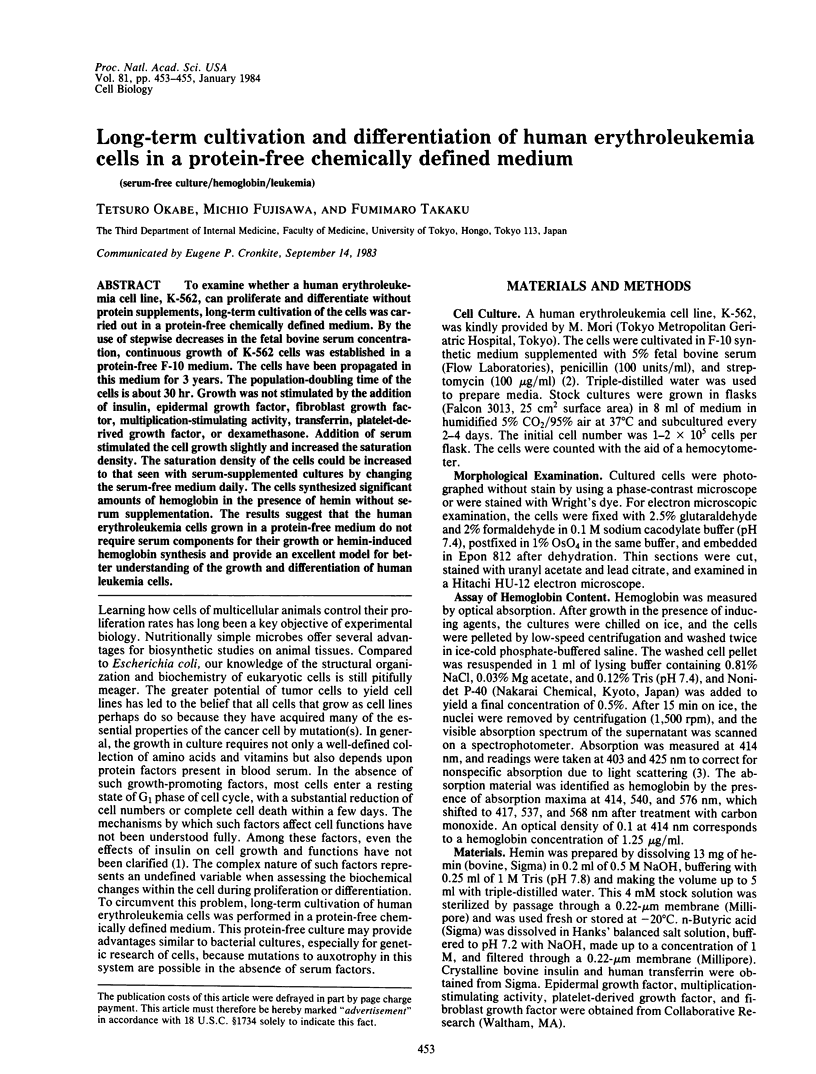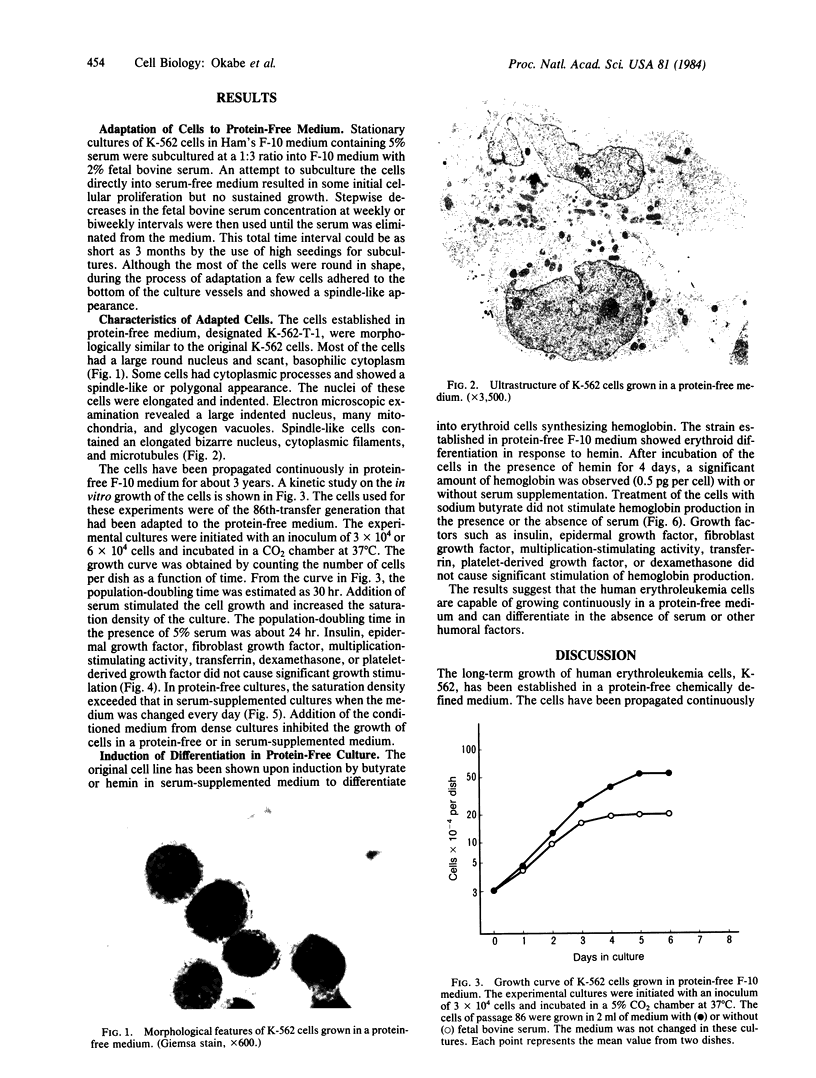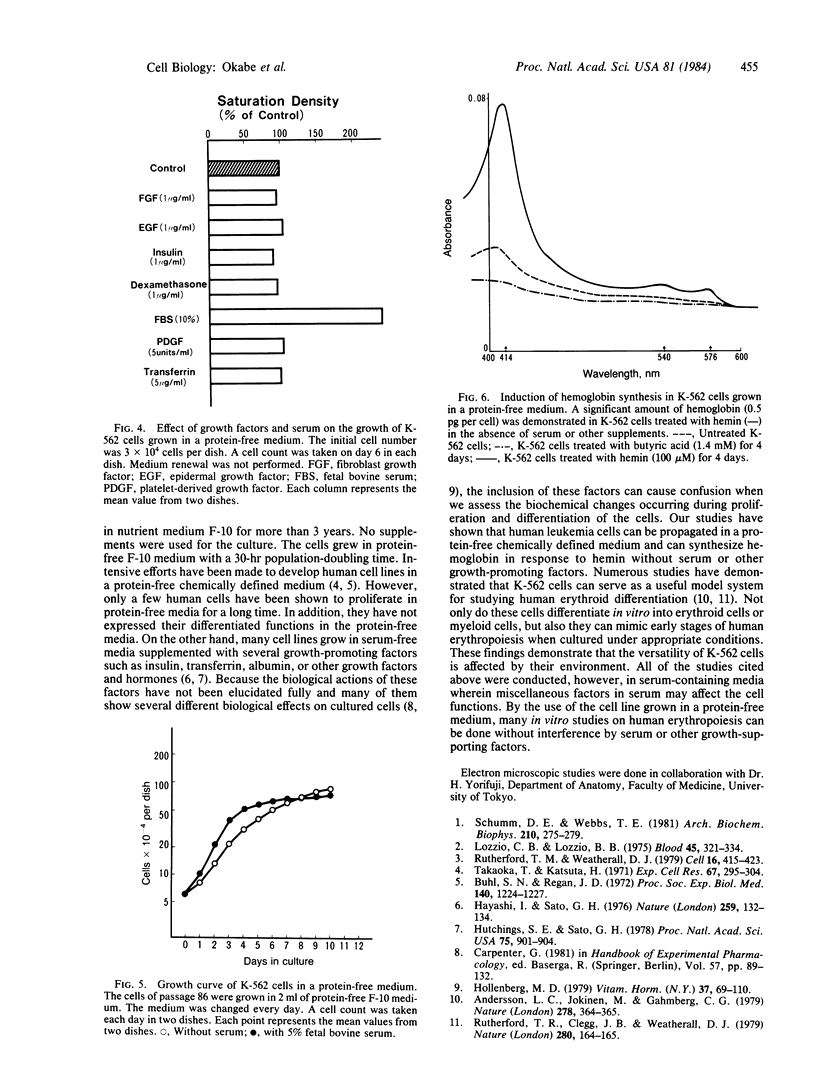Abstract
To examine whether a human erythroleukemia cell line, K-562, can proliferate and differentiate without protein supplements, long-term cultivation of the cells was carried out in a protein-free chemically defined medium. By the use of stepwise decreases in the fetal bovine serum concentration, continuous growth of K-562 cells was established in a protein-free F-10 medium. The cells have been propagated in this medium for 3 years. The population-doubling time of the cells is about 30 hr. Growth was not stimulated by the addition of insulin, epidermal growth factor, fibroblast growth factor, multiplication-stimulating activity, transferrin, platelet-derived growth factor, or dexamethasone. Addition of serum stimulated the cell growth slightly and increased the saturation density. The saturation density of the cells could be increased to that seen with serum-supplemented cultures by changing the serum-free medium daily. The cells synthesized significant amounts of hemoglobin in the presence of hemin without serum supplementation. The results suggest that the human erythroleukemia cells grown in a protein-free medium do not require serum components for their growth or hemin-induced hemoglobin synthesis and provide an excellent model for better understanding of the growth and differentiation of human leukemia cells.
Full text
PDF


Images in this article
Selected References
These references are in PubMed. This may not be the complete list of references from this article.
- Andersson L. C., Jokinen M., Gahmberg C. G. Induction of erythroid differentiation in the human leukaemia cell line K562. Nature. 1979 Mar 22;278(5702):364–365. doi: 10.1038/278364a0. [DOI] [PubMed] [Google Scholar]
- Buhl S. N., Regan J. D. Growth of a human leukemia cell line on protein-free medium. 1. Proc Soc Exp Biol Med. 1972 Sep;140(4):1224–1227. doi: 10.3181/00379727-140-36646. [DOI] [PubMed] [Google Scholar]
- Hayashi I., Sato G. H. Replacement of serum by hormones permits growth of cells in a defined medium. Nature. 1976 Jan 15;259(5539):132–134. doi: 10.1038/259132a0. [DOI] [PubMed] [Google Scholar]
- Hollenberg M. D. Epidermal growth factor-urogastrone, a polypeptide acquiring hormonal status. Vitam Horm. 1979;37:69–110. doi: 10.1016/s0083-6729(08)61068-7. [DOI] [PubMed] [Google Scholar]
- Hutchings S. E., Sato G. H. Growth and maintenance of HeLa cells in serum-free medium supplemented with hormones. Proc Natl Acad Sci U S A. 1978 Feb;75(2):901–904. doi: 10.1073/pnas.75.2.901. [DOI] [PMC free article] [PubMed] [Google Scholar]
- Lozzio C. B., Lozzio B. B. Human chronic myelogenous leukemia cell-line with positive Philadelphia chromosome. Blood. 1975 Mar;45(3):321–334. [PubMed] [Google Scholar]
- Rutherford T. R., Clegg J. B., Weatherall D. J. K562 human leukaemic cells synthesise embryonic haemoglobin in response to haemin. Nature. 1979 Jul 12;280(5718):164–165. doi: 10.1038/280164a0. [DOI] [PubMed] [Google Scholar]
- Rutherford T. R., Weatherall D. J. Deficient heme synthesis as the cause of noninducibility of hemoglobin synthesis in a Friend erythroleukemia cell line. Cell. 1979 Feb;16(2):415–423. doi: 10.1016/0092-8674(79)90017-5. [DOI] [PubMed] [Google Scholar]
- Schumm D. E., Webb T. E. Insulin-modulated transport of RNA from isolated live nuclei. Arch Biochem Biophys. 1981 Aug;210(1):275–279. doi: 10.1016/0003-9861(81)90190-9. [DOI] [PubMed] [Google Scholar]
- Takaoka T., Katsuta H. Long-term cultivation of mammalian cell strains in protein- and lipid-free chemically defined synthetic media. Exp Cell Res. 1971 Aug;67(2):295–304. doi: 10.1016/0014-4827(71)90412-5. [DOI] [PubMed] [Google Scholar]




